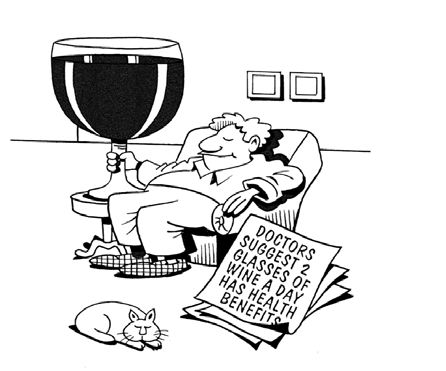Wine is Good News for Health in 2009
“For an American wine culture to flourish, the industry must actively
embrace education - not only terroirs and wine’s role in a healthy lifestyle,
but also the risks and the need for responsible consumption.”
Richard Mendelson, From Demon to Darling: A Legal History of Wine in America
Thirty-five years of research supports the notion that red wine, if consumed in moderation and combined with a
healthy lifestyle that includes adherence to the Mediterranean diet and exercise, can offer significant health
benefits. The scientific community believes that it is a combination of alcohol and various polyphenols that give
red wine its healthful properties, and that red wine can best exert its effects over the course of a lifetime, that is,
through regular, daily consumption in moderation with meals.
Our primordial ancestors were the first to discover the benefits of imbibing alcohol. Orangutans, with whom we share 97% of our DNA, are known to gather durians, tropical fruits that are native to Southeast Asia, split them
open and put them in a hole in the ground to ferment. After a suitable time, the level of alcohol in the
decomposed fruit can reach the levels found in strong beers. The orangutans gorge themselves on the
alcoholic fruit and become inebriated. Robert Walgers wrote about this “durian ceremony” in The World of Fine
Wine (Issue 28, 2008). He said, “After feasting on the alcoholic pulp, the orangutans will have sex with
partners they would not normally have slept with, they will fight old friends and bond with old enemies, they will
stumble and fall only to get up smiling, they will laugh at each other and themselves, and they will throw their
heads back and howl at their gods. Their emotions and passions will come to the fore. We recognize this ritual
because most of us have been there before. It proves that alcohol consumptions is primordial, not cultural, as
was often assumed, and that drinking for effect predated civilization, predated humanity.”
Walgers goes on to point out that other primates such as gibbons, chimps and gorillas eat a diet rich in fruit,
and imbibe significant amounts of alcohol through their consumption of overripe fruits. This behavior would
lead one to conclude a role of alcohol in natural selection because the ability to smell alcoholic fumes given off
by very ripe fruit would be an advantage in the wild as decomposing fruits are the most nutritious due to their
high calorie ethanol content. The alcohol also may have had the advantage of acting as an appetite stimulant
and creating more social interaction and procreation. Could it be that primates who lived longer and suffered
less disease consumed alcohol regularly?
The United States is projected to lead the world in volume of wine consumed by the year 2010. Appropriate
education of the public about regular, moderate and responsible drinking of wine could have a highly beneficial
effect on the health of this country. It is estimated that 80 million Americans have cardiovascular disease, or
one in three people, and cardiovascular disease is our country’s number one cause of death and disability.
About every 25 seconds an American has a coronary attack and nearly 2,400 Americans die of cardiovascular disease every day. Scientific research has strongly suggested
that the moderate intake of alcohol, particularly as red wine, can reduce the risk of atherosclerosis and heart
attacks by up to 70% when it is incorporated into a healthy lifestyle in which one avoids smoking, stays lean,
exercises regularly (30 minutes a day) and follows a diet that includes vegetables and fruits, whole grain foods,
fish, lean meats, low-fat dairy products and minimal salt intake.
As recently as 1991, the federal government’s Dietary Guidelines for Americans advised adults not to drink at
all. Alcoholic beverages were said to have “no net health benefit, were linked with many health problems, were
the cause of many accidents, and could lead to addiction.” In the same year, Morley Safer hosted a television
feature on 60 Minutes about a health conundrum known as the “French Paradox.” Safer was a Francophile
and his neighbor was the French-born chef, Jacques Pépin, who told Safer that the French had a very low rate of cardiovascular disease. The program spotlighted two medical experts: Curtis Ellison, M.D., Professor of
Preventive Medicine and Epidemiology at Boston University School of Medicine, and Serge Renaud, M.D.,
Professor of Cardiology and Research Director at Sagalen University, Bordeaux, France.

The French Paradox was that the French consumed a diet high in saturated fat, smoked
more, and exercised less than Americans, but the French had 40% fewer heart attacks
and lived on average about two and a half years longer. The French drank moderate
amounts of red wine regularly with meals, they ate more fresh fruit and vegetables, ate
more leisurely and snacked little, ate leaner and smaller portions of red meat, consumed
dairy fat as cheese rather than milk, and used more olive oil and less butter in their
cuisine. Ellison told Safer that of all of these factors, the association between improved
cardiovascular health and longevity and moderate and regular consumption of wine with
meals was strongest and supported by the most scientific evidence. The French
researcher, Serge Renaud, had discovered a relationship between the low rate of
cardiovascular disease and moderate wine intake in the French population, and
supported Ellison’s beliefs in the telecast. Renaud thought that the negative effects of
saturated fats were counteracted by the intake of wine.
At the end of the show, Safer asked Renaud to what he attributed the observed decreased mortality rate from
cardiovascular disease among the French. Renaud replied, “I think it is the alcohol.” Safer ended the program
holding up a glass of red wine and said, “The answer may be in the glass.” Approximately 33.7 million
Americans watched the show. Most were surprised by the idea that drinking might be good for you. Within
one month, the sales of red wine increased by 44% and E. & J. Gallo Winery had to put their leading seller,
Hearty Burgundy, on allocation.
Research has now shown that the health benefits of wine are due to alcohol and the polyphenolic compounds
found in the skin and seeds of grapes. It appears that the high levels of polyphenols in red wine give it superior
health advantages over other alcoholic drinks. Polyphenols in red wine are extracted by the alcohol formed
during the fermentation process. The alcohol also keeps the polyphenols chemically stable in wine. White wine
grapes have small amounts of polyphenols in their skins, but since the skins and seeds are usually not used in
white wine vinification, white wines have less polyphenols (40 mg in one glass compared to 200 mg in one
glass of red wine). It is estimated that the polyphenol content of the average diet can be enhanced by 40%
through the intake of two glasses of red wine a day.
Grapes, grape juice and raisins are not equivalent substitutes for wine as they lack the alcohol that keeps
polyphenols firmly fixed in solution. Their resulting low polyphenol content would require the ingestion of large
quantities resulting in the intake of significantly more calories to obtain the same benefit as wine.
In 2005, the United States government conceded in the Dietary Guidelines published that year that alcohol in
moderation may offer health advantages. “Alcohol may have beneficial effects when consumed in moderation
in middle-aged and older adults. The lowest all-cause mortality occurs at an intake of one to two drinks per
day. The lowest coronary heart disease mortality also occurs at an intake of one to two drinks per day.
Morbidity and mortality are highest among those drinking large amounts of alcohol. Those who choose to drink
alcoholic beverages should do so sensibly and in moderation - defined as the consumption of up to one drink
per day for women and up to two drinks per day for men. It is not recommended that anyone begin drinking or
drink more frequently on the basis of health considerations.” In contrast Great Britain’s Royal College of
Surgeons advises dry British subjects to “get wet for the good of their hearts” (the first government in the world
to make such a recommendation). See page 5 to read the results of the latest study by Curtis Ellison, M.D. on
the potential reduction in mortality among those abstainers who begin drinking moderately.
In the pages to follow, I will summarize peer-reviewed, scientific studies published in print, online or presented
in scientific forums in 2009 along with other relevant reports that contribute to our current understanding of the
roles alcohol and in particular red wine play in our health. For the purposes of understanding “moderate
drinking,” which is frequently referenced in the following reviewed research, a few definitions need to be
understood. A standard drink (or unit) is not specifically defined in the Dietary Guidelines for Americans but it is
generally considered to contain 17.7 ml (14 grams) of ethanol which is equivalent to 12 ounces of beer, 5
ounces of wine, or a shot of 8-proof distilled spirits. The definition of a standard drink differs widely among
countries. For example 1 US ‘drink’ = 1.5 UK units. A full bottle of wine contains roughly 5 to 7 drinks
depending on the wine’s alcohol percentage. To determine the number of drinks in a particular bottle of wine,
multiple 750 ml by the alcohol percentage and divide by 17.7. For example, one drink from a bottle of 13.0%
alcohol wine will equal 750 ml x 0.13 = 97.50 divided by 17.7 = 5.5 drinks. A bottle of 16% alcohol wine will
contain 6.8 drinks or about 1 more drink than a bottle of 13% alcohol. This illustrates the fact that alcohol
percentage does make a difference when the consumer is looking to drink in moderation.

The definition of levels of drinking vary, but usually moderate drinking is defined as no more than 1 drink per
day for women and no more than 2 drinks per day for men. Some liberal definitions set the limit at less than 3
drinks per day. You do not get additional beneficial effects from drinking more than this. Heavy drinking is
defined as 3 or more drinks per day. To stay within the confines of moderation, a drinker would want to scale
back the volume of drinking when imbibing a wine with a higher alcohol percentage, or reach for a lower
alcohol wine.

Good wine challenges our human frailties, because if it tastes good, we want to drink more of it. Over drinking
or binge drinking (more than 4 drinks on a single occasion for men or more than 3 drinks for women) should be
avoided as it can lead to a number of health problems including sudden death from high blood pressure, heart
attack, cardiac arrhythmia, or stroke. You are better off not drinking at all than drinking too much. Constant over
drinking can result in cardiac myopathy, cirrhosis of the liver, acute alcoholic hepatitis, osteoporosis, chronic
gastritis, irritable bowel syndrome, tremors, insomnia, nightmares and night sweats, dementia, cancer of the
mouth, pharynx, larynx, esophagus, stomach, liver, colon and breast. NIH data shown below, although
outdated, is still relevant, and shows the relative increased risk of certain health conditions in heavier drinkers
(2 or more drinks per day).
As an informed physician, I am with the majority of health experts who are confident that wine in moderation is
good for you, especially for middle-aged to older people. My prescription is 5 to 10 ounces of red wine to be
enjoyed most days and consumed with food. The cardioprotective benefits of wine are most pronounced when
wine is drunk daily and regularly with meals. That said, wine drinking may not be advisable for everyone, and
one should consult with their doctor about the effects of wine consumption on their health.